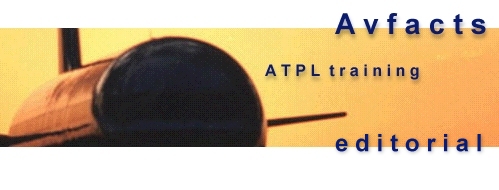




 |
 |
  |
 |
Aircraft Systems Topic 21.
B767 EHSI - Expanded ILS mode
| There are six different EHSI
modes which can be set by the crew using the EHSI control panel. In this
mini editorial we will be looking at the “Expanded ILS” mode.
This mode displays a simplified, uncluttered 70 degree compass arc presentation. Orientation Like the Full ILS it is oriented magnetic HEADING UP. Weather radar returns CAN be displayed in Expanded ILS mode, but cannot be shown in “Full ILS” mode. Aircraft Symbol Unlike the Full ILS mode, the aircraft symbol is shown as a white triangle at the bottom of the screen. The aircraft’s exact position is at the tip of this triangle.
ILS selection/distance The fact that ILS is feeding tracking information to the screen is displayed in green at the bottom left-hand corner of the screen, whilst the distance to that station is in the upper left corner. The ILS frequency is displayed in green in the bottom right-hand corner. Inbound course of the localiser is 282 magnetic. Distance to the ILS is 15.4 nm. CDI bar/aircraft orientation If the CDI bar is to the left of the aircraft, the desired track is to the left, and vice versa. Turn toward the needle to intercept track. Track made good (TMG) When related to the current heading, this shows the degrees of drift occurring. In this case eleven degrees left drift. Track made good (TMG) is 252M/heading 263M. This is logical as the wind arrow shows a wind from the right, being about 330M at 20 knots. Course selector arrow The ILS localiser course for this runway is 282M, and the aircraft is slightly right of that course but closing on it. Calibration is half a degree per dot, and is automatically loaded when an ILS frequency is tuned. If an VOR frequency was tuned, the calibration would be automatically set at two degrees per dot. With this combination of wind from the right, aircraft close to the station, and an effective cut angle of 30 degrees, the aircraft would soon need to be turning right so as not to pass through the localiser inbound course. TO/FROM flag The TO/FROM flag is NOT shown when an ILS is tuned. CDI scale This appears at 90 degrees to the course selector arrow on a HSI, not horizontally as is the case in the basic (conventional) VOR/ILS instrument. Glideslope This is displayed at the bottom right-hand corner. The aircraft is slightly below the glideslope. This mini-editorial is an abbreviated sample from the book “Flying Glass”, and from the soon to be released online ATPL “Aerodynamics and Aircraft Systems” course. Knowledge of EHSI modes form part of the Australian Civil Aviation Safety Authority (CASA) ICAO ATPL syllabus. For more information go to www.aviationshop.com.au/avfacts/atp and www.aviationshop.com.au/avfacts/Study_texts.htm and www.aviationshop.com.au/avfacts/avfacts/atp/default.htm This is one of a series on the B767 EFIS displays - check the editorial index for the others. An interesting website within Boeing is that related to the quarterly AERO e-magazine. One particular article to complement what you have read here can be found at: http://www.boeing.com/commercial/aeromagazine/aero_09/flight_story.html This e-magazine number 9 includes details of the new B767-400 flight deck. Best wishes Rob Avery ATPL Instructor
|
